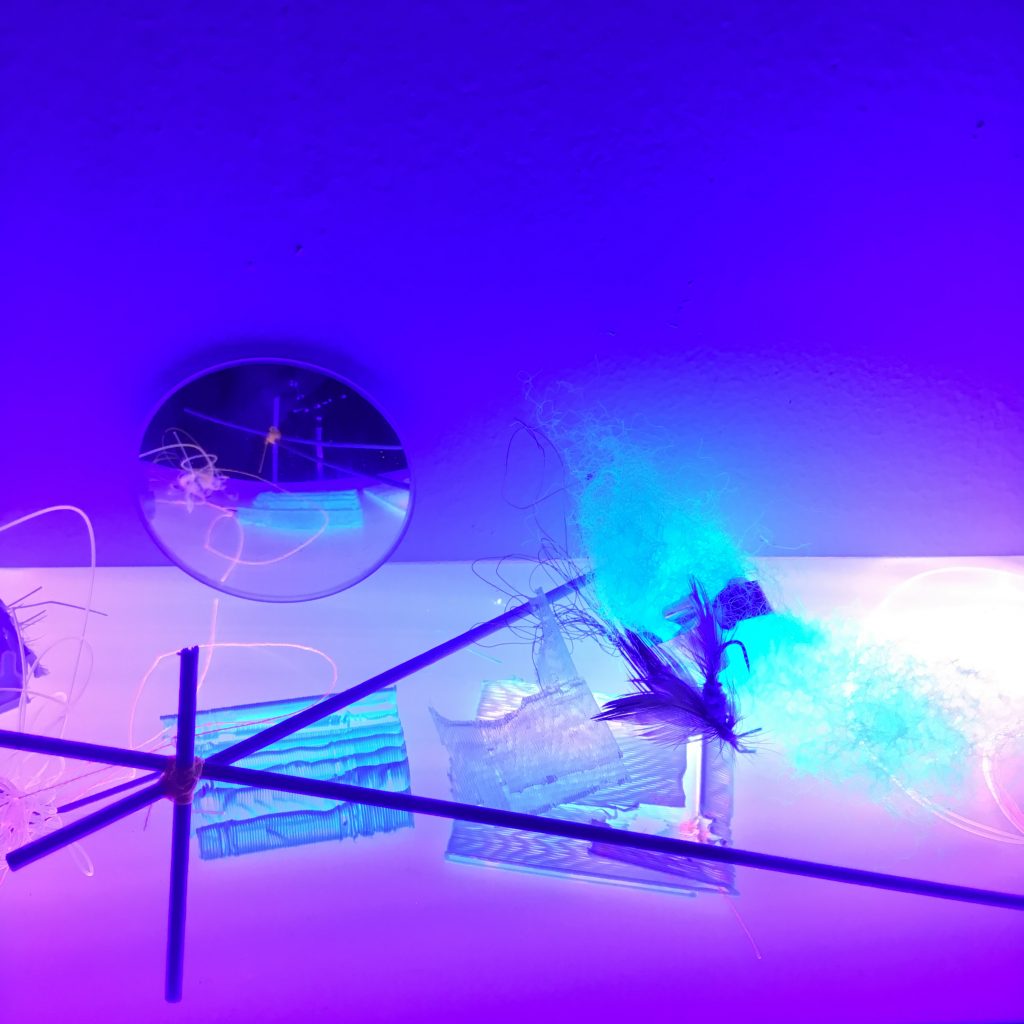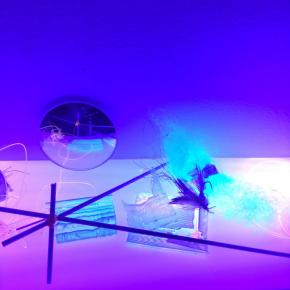Announcement
Boston, MA —

Emerson College’s platform for presenting contemporary visual and performance art “Emerson Contemporary” proudly presents Spacetime (x, y, x + t), a multi-dimensional exhibition that features experimental works by regional and international artists Katherine Mitchell DiRico (US), Monika Grzymala (GER), Nicole L’Huillier (CL), Zsuzsanna Szegedi (HUN), and Sarah Trahan (US).
The exhibition opens Wednesday, January 22, 2020 with an artists’ reception from 5:00 p.m. to 7:00 p.m. and runs through March 15, 2020. It will be held at Emerson Contemporary’s Media Art Gallery, located at 25 Avery Street in Boston, which is open Wednesday through Sunday from 12:00 p.m. to 7:00 p.m. The exhibition and related programming are free and open to the public.
Curated by Dr. Leonie Bradbury – Emerson’s Foster Chair of Art Theory and Practice and Distinguished Curator-in-Residence – the exhibition features digital projections, 3D printed objects, inkjet prints, VR drawings, video, site specific light installation, and a dancing robot. In putting together this exhibition, Bradbury considered how our perceptions are challenged and consequently change when artists include a durational element into an otherwise object-based artistic practice. Additionally, Spacetime includes both subtle and dramatic sonic elements that, when combined with drastic scale shifts of the various installations, contribute to a compelling immersive exhibition experience.
The works included in Spacetime (x, y, x + t) investigate the dynamic relationships between objects, their materiality, and demonstrate how an idea, object, or artistic concept can ‘travel’ across time, multiple media, and physical locations. Together these five artists’ aesthetic experiments offer an exploration of the rapidly changing intersections between the physical and the digital, objecthood and performativity, and expose how the virtual and the real interact in new ways as a result of current technological advancements.
According to Bradbury, “What interests me in these works is a broader theoretical concept of ‘art as event.’ These objects, ideas, and material manifestations are assembled as dynamic relational forms, but only temporarily, as they will soon be dismantled and re-distributed back into the studio, the file cabinet, or returned to a computer folder. As such, these works – and this exhibition – are in a continual state of becoming.”
In 1905, Albert Einstein demonstrated that space and time are both relative and integrated and are essentially the same thing: a single unified entity called 'spacetime.' Spacetime is a dynamic entity that fuses the three dimensions of space (x,y,z) and the dimension of time (t) into a single, four-dimensional continuum. In curating the exhibit, Bradbury explored the question of what happens when an artwork becomes an event that exists in the four dimensions of Einstein’s concept of ‘spacetime’ - rather than as an object in space and/or time.
About the Artwork
Katherine Mitchell DiRico's room-sized installation Stilling Life in the Project Room brings together an assembly of technology, objects, video, movements, and light to question the constructed nature of reality. These materials exist in varying degrees of completion, imploring us to combine their relationships anew each time they transform. Traversing between the virtual and the material, and quite literally between two separate spaces in the gallery, Stilling Life challenges the viewer’s ability to locate oneself in time and space. Various materials – light, air, mirrors, reflections– are moving at different rhythms to create a dynamic installation that is always changing, and therefore continually becoming; much like current relationships to the real and mediatized worlds we inhabit.
Monika Grzymala’s virtual landscapes Maze_VR_one and Maze_VR_two, are autonomous, immersive, spatial drawings, designed to exist in virtual reality (VR) and can be understood as simulated spatial structures. When the viewer puts on the VR headset, they “fly” through a seemingly endless web of lines, a spherical, cosmic-looking installation while listening to the soothing sound of the artist’s heart beat. These VR drawings are an extension of Grzymala’s sculptural practice whereby she creates room sized sculptural installations using tape called “space drawings” or raumzeichnung in German. On view will be Raumzeichnung (stretch), a video work that shows the deconstruction of such a site-specific drawing and one-time kinetic sculpture (duration 7 minutes) that took place in 2016 as part of a collaborative performance project.
Nicole L’Huillier's robotic sculptureThe Dancer (2020) explores the performativity of an object as it moves across space and ‘draws’ through movement in time. The result is an unstable and irregular vibrational dance triggered by sounds emerging from its own body as the resonant frequencies of its material composition causes the object to move. Thus The Dancer dances as a way of embodying its own noise. This object is animated by sounds that are drawn as a dance across space and time. Exploring other levels of animacy and performativity, this vibrational body exists in a continuous dialogue between gravity, resonance, and trance.
Zsuzsanna Szegedi's latest work In the Fracture (2018-2020)explores the dynamics of control between human and machine, made visible through the lens of digital photography and related physical outcomes. Using a 3D image scan of her body as a point of origin, Szegedi visualizes the human-machine power dynamics through a virtual reality video simulation, a digital projection on raw clay and two 3D printed prototypes. While exploring the dimensions of space and time within the digital photographic imaging process, Szegedi shows how this medium produces distortion, breakage, and a disrupted image. In doing so, she magnifies the limitations of current imaging technologies.
Sarah Trahan’s multimedia installation Hand of the Machine (2019 - 2020) investigates digital manufacturing through its imperfections. What we commonly understand as a uniform and infinitely repeatable dialog between user, computer, and 3D printer belies a much more nuanced and imperfect system. Communication breakdowns, bugs, and evidence of the unpredictable nature of hot plastic become apparent as we look more closely. Impressions, abstractions, and mutations are interpreted through lenses, light, and ink. Hand of the Machine halts the fabrication process to focus on these aberrant details: anomalies build up, forms break down, and are reconstituted into new structures ripe for exploration.
A selection of images can be viewed and downloaded.
PUBLIC PROGRAMMING
- Wednesday, January 22, 5:00 p.m. to 7:30 p.m.
Public artist reception
- Sunday, February 2nd, 2:00 p.m.
In Conversation: Performativity of Objects featuring Katherine Mitchell DiRico and Nicole L’Huillier. Moderated by Dr. Leonie Bradbury
- Sunday, February 23, 2:00 p.m.
In Conversation: Investigating the Material featuring Sarah Trahan and Zsuzsanna Szegedi. Moderated by Dr. Leonie Bradbury
- Sunday, March 15, 2:00 p.m.
Curator tour with Dr. Leonie Bradbury

About the College
Based in Boston, Massachusetts, opposite the historic Boston Common and in the heart of the city’s Theatre District, Emerson College educates individuals who will solve problems and change the world through engaged leadership in communication and the arts, a mission informed by liberal learning. The College has 3,780 undergraduates and 670 graduate students from across the United States and 50 countries. Supported by state-of-the-art facilities and a renowned faculty, students participate in more than 90 student organizations and performance groups. Emerson is known for its experiential learning programs in Los Angeles, Washington, DC, the Netherlands, London, China, and the Czech Republic as well as its new Global Portals, with the first opening last fall in Paris. The College has an active network of 51,000 alumni who hold leadership positions in communication and the arts. For more information, visit Emerson.edu.